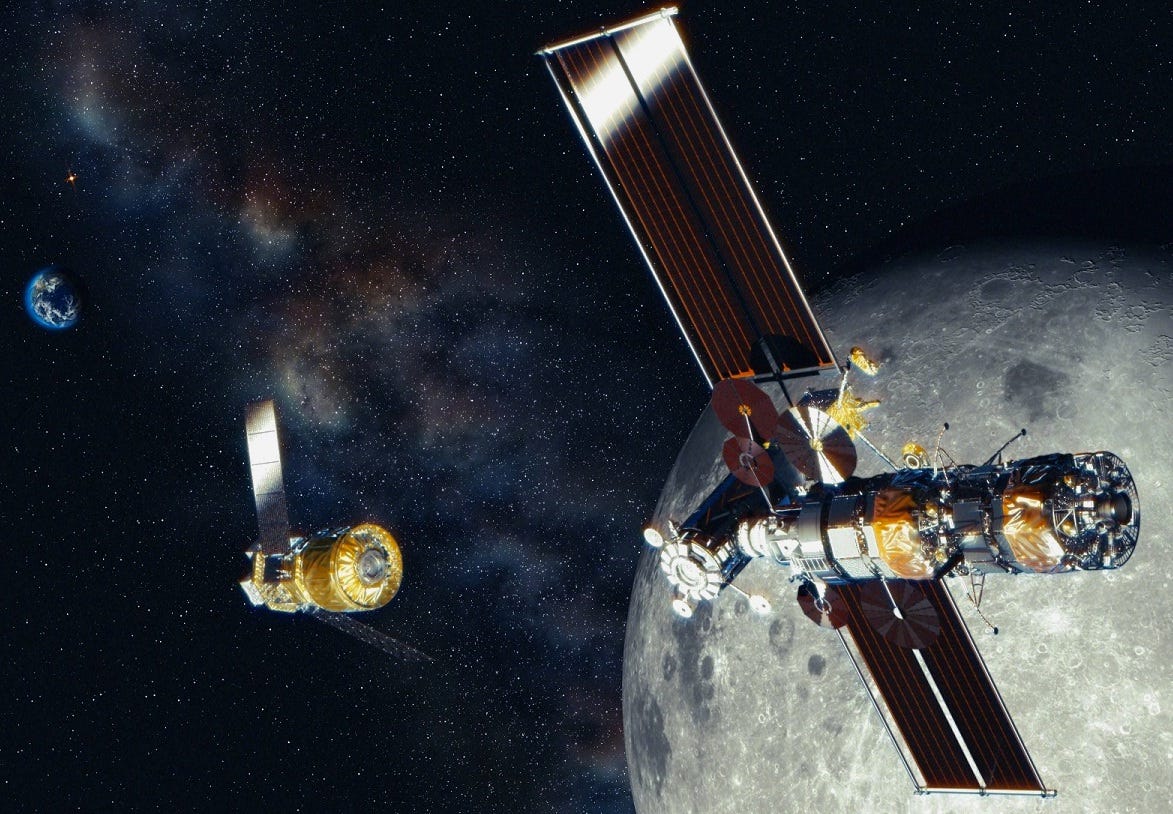Moon Monday Issue #55
Japan to recruit new astronauts for Gateway lunar station; Intuitive Machines to attempt a Moon landing selfie; carbon dioxide cold traps on the Moon confirmed, and more lunar updates.
Highlight
On November 19, Japan’s space agency JAXA announced a plan to recruit new astronaut candidates for the first time in 13 years. Selected astronauts, to be announced in February 2023, will be sent to either the International Space Station or the NASA-led Gateway lunar orbiting station, the latter of which will launch in November 2024 on a SpaceX Falcon Heavy rocket. This move is part of JAXA’s agreement with NASA to collaborate on the Gateway, wherein in return for Japan’s crucial contributions to the station, NASA will provide opportunities for Japanese astronauts to be onboard. Applications for astronaut candidates start next month. Since Japan has no active female astronauts at the moment, JAXA plans to launch a campaign to encourage women to apply.

Japan will provide life support systems to Gateway’s International Habitation (i-HAB) module, including space for the crew to live, work, and conduct research. They will also provide batteries, thermal control systems, and imagery components for the module. These capabilities will reduce the Gateway’s logistical supply demands, allowing it to host longer crewed and uncrewed operations. Japan will also supply batteries for the Gateway’s initial crew module, the Habitation and Logistics Outpost (HALO). Out of Japan’s 2021 fiscal budget of $4.14 billion, the country is spending $339 million to develop the advanced spacecraft HTV-X to supply cargo to the Gateway, and $56 million to develop Gateway technologies.
Exploration
When Intuitive Machines’ first ever spacecraft attempts to land on the Moon in early 2022, it will also attempt a clever selfie. 30 seconds before the landing, a CubeSat on the lander will detach and capture the spacecraft’s lunar touchdown using three wide field-of-view cameras while free falling. This CubeSat, called EagleCam, is built entirely by students from the Embry-Riddle Aeronautical University. They completed constructing EagleCam this month and sent it over to Intuitive Machines for integrating it onto their lander. EagleCam’s images will also help us better understand how rocket plumes interact with Moondust.
Speaking of lunar dust, two of EagleCam’s camera lenses will have a NASA-Kennedy-Center-developed electrodynamic dust shield, which will use an electric field to remove most of the fine lunar dust that accumulates on the lenses (video). The difference in image quality before and after applying the electric field will tell us how efficiently the dust removal system works.

The Orion capsules to be used on NASA’s first three crewed Artemis Moon missions are in various stages of production.
- Last month, ESA delivered the second Airbus-built European Service Module to NASA, to be used on Orion’s first crewed mission, Artemis II, by May 2024. The 15,000-kilogram module provides propulsion, water, oxygen, thermal control, and electrical power to Orion. Next, NASA and Lockheed Martin will integrate it with Orion’s Crew Module Adapter and Crew Module.
- In September, NASA completed welding Orion’s pressure vessel to be used on the Artemis III mission, wherein Orion will dock with a SpaceX Starship in lunar orbit, following which Starship will land the first Artemis astronauts on the Moon. Lockheed Martin is currently manufacturing the mission’s Orion Crew Module and Crew Module Adapter structure.
- Last week, a huge Super Guppy aircraft transported Orion’s heat shield for Artemis IV near NASA Ames, where it will undergo heat- and pressure-treatment to gain the necessary mechanical strength to survive a fiery atmospheric entry on Earth.
NASASpaceflight has a great in-depth interview on Orion’s production progress.
Science
Using 11 years of temperature measurements from NASA’s Lunar Reconnaissance Orbiter, scientists have confirmed the presence of carbon dioxide cold traps on the Moon. These require much colder temperatures even in permanently shadowed regions compared to relatively easily trapped water ice. The authors estimate 200 square kilometers of carbon dioxide traps spread across the Moon’s south pole, compared to the nearly 14,000 square kilometers of water ice traps. This doesn’t mean all the identified traps have carbon dioxide but that it’s likely, especially considering the gas was detected in the impact plume created by NASA’s LCROSS mission in 2009.

These new maps will help future missions better find concentrated carbon dioxide, an extremely scarce resource on the Moon and one important for producing rocket fuel, biomaterials and more as we seek to establish sustained lunar presence. From a scientific standpoint, it gives us more specific areas that could offer a pristine record of cometary and asteroid bombardment from the solar system’s early days, something tied to the origin of Earth and the Moon. Carbon dioxide being a scarce lunar resource and geographically highly concentrated also has governance and policy implications as specific areas on the Moon’s south pole will become hot targets.
More Moon
The Algerian-based “popular science” Chihab Science magazine has released a special Moon-themed issue, including exclusive interviews with some well known scientists such as James Head who helped train the Apollo astronauts in geology, and Farouk El-Baz who helped select Apollo landing sites.

Thank you Epsilon3 for supporting me and powering this edition of Moon Monday.
Everyone, this one-of-a-kind Moon exploration newsletter is free, with no ads. And it will stay that way. If you like my work, your support will keep it going.
